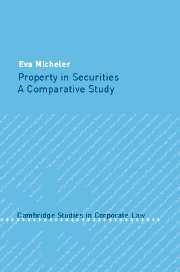Part II - German and Austrian law
Published online by Cambridge University Press: 28 July 2009
Summary
In German and Austrian law most securities are issued in the form of bearer instruments and these instruments are considered to be tangibles. The underlying theory in modern German law is that securities certificates are paper documents of a very special type. The right to which the paper document relates materialises in the document and can therefore be transferred according to the rules governing tangibles. If the paper document is transferred, the buyer not only acquires title to the paper, but also becomes entitled to the right to which the paper relates. The German-language term for German securities is ‘Wertpapier’ and is used in both German and Austrian usage. The word ‘Wertpapier’ literally means ‘paper of value’ and the term refers to the fact that the document relating to the security embodies a valuable right. The term is also designed to reflect the theory underlying German and Austrian securities, that the rights to which the securities certificate relates and the certificate merge and become one tangible asset. As a result, securities, their transfers and indirect holdings of securities are all subject to the rules governing tangible assets.
The analysis adopted by modern German and Austrian law, however, emerged only some time after securities were first issued. In chapter 9, the historic starting point and the development that led to the modern German theory will be examined. First, the rules governing securities when they emerged will be analysed (section 9.1).
- Type
- Chapter
- Information
- Property in SecuritiesA Comparative Study, pp. 145 - 148Publisher: Cambridge University PressPrint publication year: 2007

